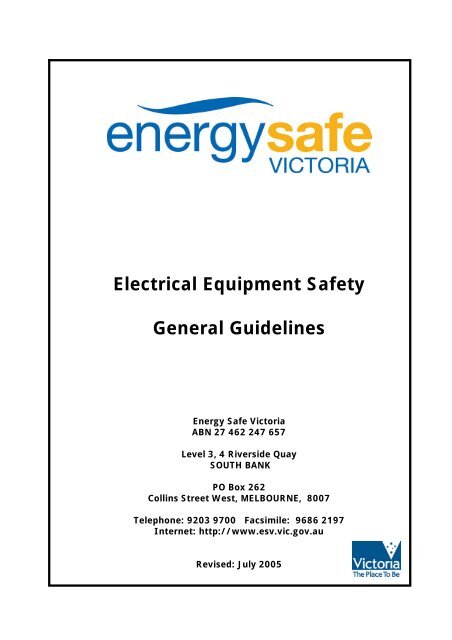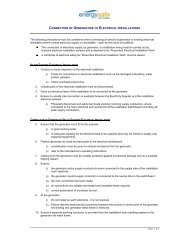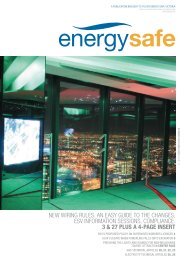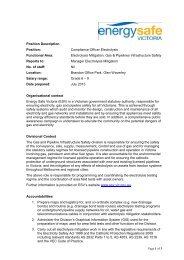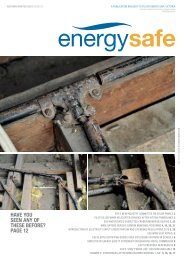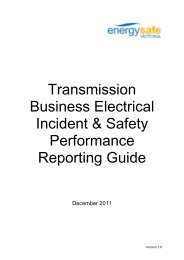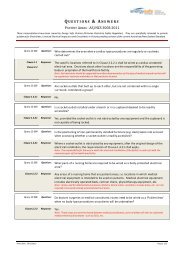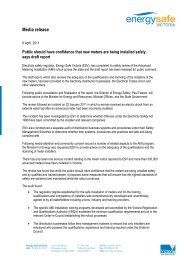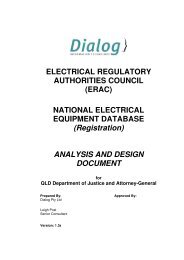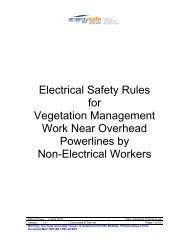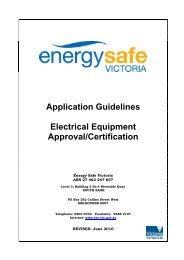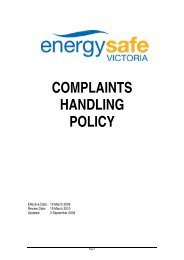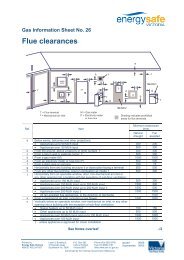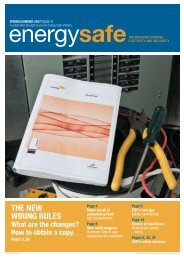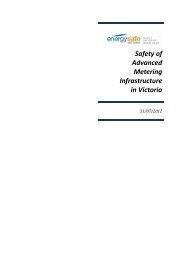Electrical Equipment Safety General Guidelines (PDF) - Energy Safe ...
Electrical Equipment Safety General Guidelines (PDF) - Energy Safe ...
Electrical Equipment Safety General Guidelines (PDF) - Energy Safe ...
Create successful ePaper yourself
Turn your PDF publications into a flip-book with our unique Google optimized e-Paper software.
ELECTRICAL EQUIPMENT SAFETY FRAMEWORKIn the interest of safety, the electrical regulatory authorities of each State and Territory ofAustralia administer individual, nationally uniform, reciprocal electricity safety legislationaimed primarily at preventing the supply of unsafe electrical equipment and enabling responsein the event of non-compliant or hazardous equipment.In Victoria, refer to Part 4 of the Electricity <strong><strong>Safe</strong>ty</strong> Act 1998.The Act and subordinate regulations may be accessed via the publications section of ESV’swebsite Industry - Acts, Regulations, Codes of Practice and <strong>Guidelines</strong>The safety of electrical equipment supplied or offered for supply in Australia is ensured by twocomplementary regimes.ESSENTIAL SAFETY<strong>General</strong>ly applicable(PRE-MARKET) APPROVALSpecific classes of equipment(Mandatory approval)ESSENTIAL SAFETY REGIMEThe foundation of Australian electrical equipment safety legislation is an essential safetyregime whereby electrical equipment suppliers are responsible to ensure that all electricalequipment supplied or offered for supply in Australia meets minimum safety specifications.For example;(Victorian) Electricity <strong><strong>Safe</strong>ty</strong> Act 1998, Section 543
PRESCRIBED CLASSES OF ELECTRICALEQUIPMENTAppliance connectorLiquid Heating ApplianceArc welding machineLuminaire-portable typeBayonet lampholderMassage applianceBayonet lampholder adaptorMicrowave ovenBlanketMiniature over-current circuit breakerBread toasterOutlet deviceClothes dryerPlugControl or conditioning devicePower supply or chargerCooking appliance-portable typeProjectorCord extension socketRangeCord-line switchRange hoodDecorative lighting outfitRazor/hair clipperDishwasher machineRefrigerating applianceEdison screw lampholderResidual current deviceFanRoom heaterFence energizerSewing machineFlexible heating padSocket-outletFloor polisher/scrubberSoldering ironFluorescent lamp ballastSupply flexible cordFluorescent lamp starterSwimming pool/spa equipmentHair care applianceTelevision receiverHedge clipperTherapeutic lampImmersion HeaterTool-portable typeInsect electrocutorVacuum cleanerInspection handlampWall switchIronWashing machineKitchen machineWater bed heaterLawn care applianceWater heaterStrikethrough identifies classes that have been de-prescribed in Victoria.7
APPROVAL MARKINGApproved electrical equipment must display the approval marking assigned by the issuingapproval authority.The means of marking is not specifically defined, except that it must be legible, indelible andon a normally visible part of the equipment.APPROVAL MARKING OPTIONS• Unique approval marking• Regulatory compliance mark (RCM)UNIQUE APPROVAL MARKThe details of the marking may vary between authorities.The approval marking allocated by the (regulatory) approval authorities is typically analphanumeric code comprising the first letter of the State of the issuing approval authorityfollowed by between one and six digits.For example, the approval marking issued by (ESV in) Victoria could beV3V05887(in this example the first two numerals indicate the year of issue of the approval)Or for products approved in other states:• Queensland issued approval marking Q05887• New South Wales issued approval marking N18887• South Australian issued approval marking S263• Tasmanian issued approval marking T05887REGULATORY COMPLIANCE MARKThe regulatory compliance mark (RCM) is a graphic symbol that may optionally be used,subject to specific conditions, to indicate a supplier’s claim that a product meets applicableregulatory requirements.8
The RCM is a multi-jurisdictional symbol covering the regulatory regimes of electrical safety,electromagnetic compatibility (EMC) and radio communications.The conditions for use of the RCM are described in detail in joint Australian/New ZealandStandard AS/NZS4417.1 “Marking of electrical products to indicate compliance withregulations Part 1: <strong>General</strong> rules for use of the mark”.In brief, registered suppliers may apply the RCM to equipment that satisfies the relevantregulatory requirements of all (three) applicable jurisdictions.Although no specific (safety regulatory) permission is needed to use the RCM, suppliers arerequired to be registered with the RCM registrar at Standards Australia.Further information about the RCM can be obtained from Standards Australiawww.standards.com.au/rcmSECOND-HAND EQUIPMENTSecond hand prescribed classes of equipment need not be (or have been) approved nor exhibitan approval number provided that;• the equipment is labelled second-hand;• the equipment is not subject to withdrawal of approval, recall or prohibition of supply;and• if supplied in the course of business; either• the equipment be inspected and tested to ensure compliance with AS/NZS 3760 andlabelled to show compliance; or• the equipment be clearly marked “DANGER DO NOT USE OR CONNECT TOSUPPLY – THIS ELECTRICAL EQUIPMENT MAY BE FAULTY ANDSHOULD BE INSPECTED AND TESTED BY A COMPETENT PERSON INACCORDANCE WITH AS/NZS 3760Whether new or second-hand, electrical equipment not included in the list of 52 prescribedclasses may be supplied or offered for supply without having been approved, however it is theresponsibility of the supplier to ensure that such equipment is safe. In this respect it isrecommended that all second hand electrical equipment be subjected to the provisions listedabove.9
INTER-AUTHORITY CONSULTATIONAustralian electrical regulatory authorities have well-established communication andconsultation channels through ERAC and the ERAC <strong>Equipment</strong> <strong><strong>Safe</strong>ty</strong> Working Group and bydirect consultation between Officers of the various authorities.Authorities assist each other whenever possible to investigate electrical incidents, accidents,hazards and compliance.COMPLIANCEAPPROVAL COMPLIANCERegulatory authorities conduct routine, regular marketplace surveillance to ensure supplierscompliance with (approval regulation) registration requirements.In Victoria alone, ESV audits approximately 1,000 prescribed products per annum; nationallyapproximately 11,700.SAFETY COMPLIANCEAdditionally, regulatory authorities conduct a coordinated national equipment check-testingprogram.This initiative targets particular characteristics of specific equipment types that, at theparticular given time, exhibit in-service failure trends or otherwise demand particular scrutiny;for example to ensure compliance with particular critical requirements.Recent targeted classes of equipment include:• Breadmakers (fire hazard)• Fans (fire hazard)• Room heaters (fire hazard)• Televisions (fire hazard)• Hair dryers (electric shock hazard)• Portable power tools (electric shock hazard)• ELV Power supply units (electric shock hazard)• Outlet devices (multi-outlet power-boards) (fire and electric shock hazard due tosuspected non-resilient socket contacts)• Socket outlets (GPOs) (dimensional compliance)• Supply flexible cords (size)10
ENFORCEMENTBecause separate legislation is applicable in each State and Territory, Australian electricalregulatory authorities posses varying enforcement provisions that may include the following-Agreements to cooperate with or authority to enlist cooperation of other authorities (e.g. Police,fire services, OH&S and consumer affairs regulators);Issue directives to:• Cease to supply (or offer to supply) equipment• Cease to use equipment• Cease a particular practice• Recall supplied equipment• Publish safety warnings• Provide information• Modify equipmentPowers to:• Enter premises• Seize evidence• Seize equipmentIssue infringement notices (on-the-spot fines);Prosecute;Publish notices, warnings or alerts;Withdraw approval.11


